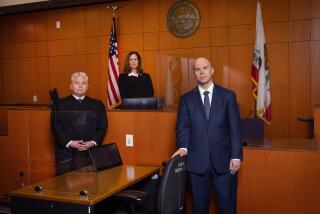Video-Link System Would Allow Courts to Arraign by Phone
ANAHEIM — In the mass arraignments clogging Los Angeles courtrooms after last week’s rioting and looting, Mark Thompson sees a problem that he hopes to solve.
His company, CJ Comm Corp. in Mission Viejo, is marketing a computerized video system that could speed the legal system by enabling courts to arraign suspects by video telephone links without moving them from jails to courthouses.
“This system would allow the courts to arraign people in a video conference from the jail itself,” said Thompson, 33, company president. “It could be used to speed the arraignment process and provide an added measure of security.”
Thompson said the arraignment system needs to be more efficient, since courts--except under emergency circumstances--must either charge suspects within 48 hours of arrest or release them.
CJ Comm’s LegalLink system, which the company has begun shipping to a few test customers, consists of a network of camcorders and computers in as many as four remote locations linked by special phone lines. The network would keep a lawyer’s office, courthouse, district attorney’s office and the jail in constant contact. Thompson demonstrated the technology at a high-tech trade show Wednesday at the Anaheim Convention Center.
The image and voice of each participant in a typical court hearing--a judge, prosecutor, defense attorney and suspect--are transmitted over special Pacific Bell phone lines capable of transmitting voice and data signals simultaneously, Thompson said. The system transmits images at about 10 to 12 frames a second. The effect is almost cartoon-like compared to the 30 frames a second on television.
“We’re targeting the criminal justice system,” he said. “We think we can make it more productive and reduce its costs, and from the past few days we have seen how important that is.”
Audiovisual arraignment became legal in California in 1983, when two-way systems were developed for test projects. Under the law, suspects have the right to be arraigned in person. Thompson said four-way communication became cost-effective in the past several years.
For the past three years, privately held CJ Comm has invested about $1 million in developing the computer hardware and software required for the task of linking courtrooms electronically. The computers include video compression boards, or components which act as a sort of trash compactor to simplify the transmission of large bits of video data through a phone line.
If sales take off, Thompson said, the four-way video communication system has potential applications beyond jails and courthouses.
For instance, on Friday the company will begin demonstrating the video system for the city government in Cypress, which hopes to use the system to hold video conferences with the public.
The system might also be used in education to teach classes long distance. In prisons, it could allow instructors who might be afraid to teach in person to interact with inmates through a comfortable electronic facade.
C. W. Shepherd, vice president of governmental affairs for the company, said the company understands that state and local governments are under intense financial pressure and may not be able to afford the system, which could cost about $20,000 for each workstation.
More to Read
Sign up for Essential California
The most important California stories and recommendations in your inbox every morning.
You may occasionally receive promotional content from the Los Angeles Times.








